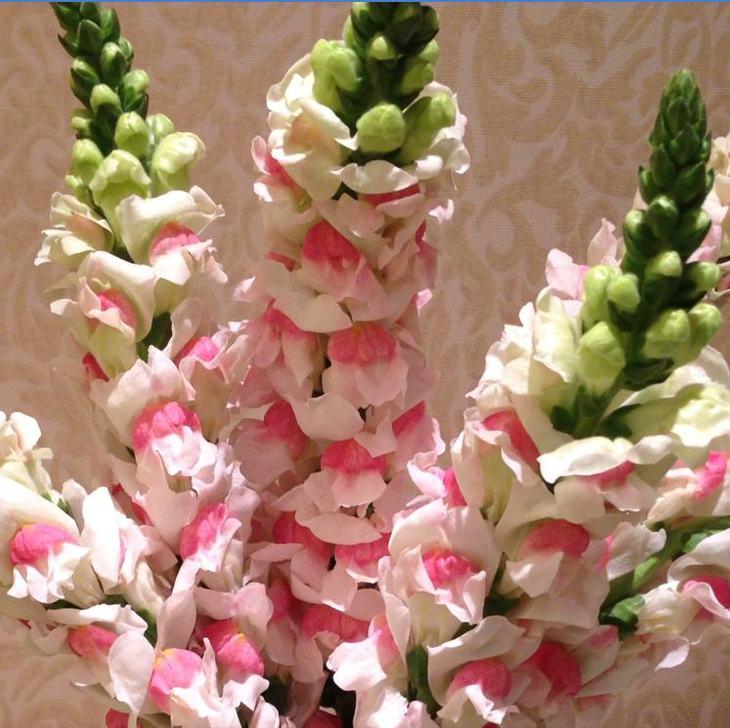文章
Colour_
2017年07月11日

管花杜鹃形态特征
常绿直立灌木,高1-4(--6)米。枝条细长,幼枝带紫红色,疏生鳞片。叶散生 幼枝上,披针状椭圆形或披针状长圆形,长(3--)4-8(--15)厘米,宽1-3(--4) 厘米,顶端锐尖,基部楔形,上面暗绿色,有光泽,被褐色鳞片,鳞片相距为其直径的 1--3倍,下面苍绿色,被密而不等大的褐色至暗褐色的鳞片,相距为其直径或不及,侧脉明显;叶柄长5-12毫米,被鳞片。花序顶生或腋生,短总状,通常有4-6花;花梗长4-8毫米,纤细,带红色,有鳞片;花萼小,长约1毫米,浅5裂或仅为边檐 状,无鳞片;花冠管状,一面稍臌胀,长1.8-2.5厘米,橘红、朱红或肉红色,口部 浅5裂,裂片长圆形,直立;雄蕊10,花药短小,卵圆形,花丝下部被密毛;花柱下 部常被毛,偶尔无毛。蒴果长圆形,长8-10毫米,密被鳞片。花期7月,果期10 月。

管花杜鹃的繁殖方式
扦插繁殖
扦插繁殖是杜鹃花栽培中应用最多的繁殖方法,一般在5-6月份剪取健壮的半木质化的新枝,长约5-8厘米,剪除下部叶片,保留顶叶2-3片作插穗,插穗基部最好用吲哚丁酸或ABT生根粉等溶液浸蘸处理,然后扦插在疏松透气、富含腐植质的酸性土壤中,温度保持在20-25℃,遮阴并经常喷雾保湿,以促进萌发新根。
嫩枝繁殖
嫩枝繁殖是用劈接对于难以成活的名贵品种如西鹃等,先剪去嫩枝约3-4厘米作接穗,将基部用利刀削成楔形,用毛鹃作砧木,采用嫩枝劈接,然后置阴棚下用塑料薄膜绑扎,并用塑料袋将接穗和砧木一起罩住保湿。

管花杜鹃的养殖方法
肥水管理
杜鹃生长发育要求酸性土壤。由于北方土壤多偏碱性,因此盆土需用腐熟的松针叶土等腐植土混合配制。杜鹃的根系为须状细根,对肥料浓度及水质的要求严格,施肥时要遵循适时适量、薄肥勤施的原则。春季开花前为促使枝叶及花蕾生长,可每月追施一次磷肥。花后施1-2次氮磷为主的混合肥料。9-10月份孕蕾期施1-2次磷肥。在生长期、开花期肥水要求较多,冬季休眠、夏季生长缓慢时要控制肥水,以防烂根。杜鹃花喜湿润和凉爽的环境,北方气候干燥,应及时浇水并喷雾,以保持较高空气湿度。浇花水以矾肥水及雨水为好,如用常用水需加入少量硫酸亚铁及食醋。也可将西瓜或西红柿切成小块施入,对于改善土质及花朵质量也有良好效果。
整形修剪
为加速植株盛开,杜鹃常通过摘心来促发新枝,对于花朵簇拥、影响花形的可以提早疏蕾,这样不但使当年花大色鲜,也有利于植株来年生长开花。杜鹃萌发力强,枝条严重影响植株生长发育,降低其观赏性和商品性,因此需通过修枝来调整。修枝一般在春季花谢后及秋季进行,剪去枯枝、斜枝、徒长枝病虫枝及部分交叉枝,避免养分消耗,使整个植株开花丰满。
花期控制
杜鹃在秋季进行花芽分化,通过冷藏和加温处理,可以人为控制花期。要使杜鹃提前开花,可将其移至温室培养,控温在20-25℃,并经常在枝叶上喷水,保持80%以上的相对湿度,这样经过一个半月即可开花。要使杜鹃延迟开花,可将形成花蕾的杜鹃,让其一直处于低温状态,保持温度2-4℃,盆干时浇水,夏秋移出室外,2周后即可开花。
常绿直立灌木,高1-4(--6)米。枝条细长,幼枝带紫红色,疏生鳞片。叶散生 幼枝上,披针状椭圆形或披针状长圆形,长(3--)4-8(--15)厘米,宽1-3(--4) 厘米,顶端锐尖,基部楔形,上面暗绿色,有光泽,被褐色鳞片,鳞片相距为其直径的 1--3倍,下面苍绿色,被密而不等大的褐色至暗褐色的鳞片,相距为其直径或不及,侧脉明显;叶柄长5-12毫米,被鳞片。花序顶生或腋生,短总状,通常有4-6花;花梗长4-8毫米,纤细,带红色,有鳞片;花萼小,长约1毫米,浅5裂或仅为边檐 状,无鳞片;花冠管状,一面稍臌胀,长1.8-2.5厘米,橘红、朱红或肉红色,口部 浅5裂,裂片长圆形,直立;雄蕊10,花药短小,卵圆形,花丝下部被密毛;花柱下 部常被毛,偶尔无毛。蒴果长圆形,长8-10毫米,密被鳞片。花期7月,果期10 月。

管花杜鹃的繁殖方式
扦插繁殖
扦插繁殖是杜鹃花栽培中应用最多的繁殖方法,一般在5-6月份剪取健壮的半木质化的新枝,长约5-8厘米,剪除下部叶片,保留顶叶2-3片作插穗,插穗基部最好用吲哚丁酸或ABT生根粉等溶液浸蘸处理,然后扦插在疏松透气、富含腐植质的酸性土壤中,温度保持在20-25℃,遮阴并经常喷雾保湿,以促进萌发新根。
嫩枝繁殖
嫩枝繁殖是用劈接对于难以成活的名贵品种如西鹃等,先剪去嫩枝约3-4厘米作接穗,将基部用利刀削成楔形,用毛鹃作砧木,采用嫩枝劈接,然后置阴棚下用塑料薄膜绑扎,并用塑料袋将接穗和砧木一起罩住保湿。

管花杜鹃的养殖方法
肥水管理
杜鹃生长发育要求酸性土壤。由于北方土壤多偏碱性,因此盆土需用腐熟的松针叶土等腐植土混合配制。杜鹃的根系为须状细根,对肥料浓度及水质的要求严格,施肥时要遵循适时适量、薄肥勤施的原则。春季开花前为促使枝叶及花蕾生长,可每月追施一次磷肥。花后施1-2次氮磷为主的混合肥料。9-10月份孕蕾期施1-2次磷肥。在生长期、开花期肥水要求较多,冬季休眠、夏季生长缓慢时要控制肥水,以防烂根。杜鹃花喜湿润和凉爽的环境,北方气候干燥,应及时浇水并喷雾,以保持较高空气湿度。浇花水以矾肥水及雨水为好,如用常用水需加入少量硫酸亚铁及食醋。也可将西瓜或西红柿切成小块施入,对于改善土质及花朵质量也有良好效果。
整形修剪
为加速植株盛开,杜鹃常通过摘心来促发新枝,对于花朵簇拥、影响花形的可以提早疏蕾,这样不但使当年花大色鲜,也有利于植株来年生长开花。杜鹃萌发力强,枝条严重影响植株生长发育,降低其观赏性和商品性,因此需通过修枝来调整。修枝一般在春季花谢后及秋季进行,剪去枯枝、斜枝、徒长枝病虫枝及部分交叉枝,避免养分消耗,使整个植株开花丰满。
花期控制
杜鹃在秋季进行花芽分化,通过冷藏和加温处理,可以人为控制花期。要使杜鹃提前开花,可将其移至温室培养,控温在20-25℃,并经常在枝叶上喷水,保持80%以上的相对湿度,这样经过一个半月即可开花。要使杜鹃延迟开花,可将形成花蕾的杜鹃,让其一直处于低温状态,保持温度2-4℃,盆干时浇水,夏秋移出室外,2周后即可开花。
0
0
文章
权问薇
2017年07月10日


#番杏 的播种繁殖
种子直播
番杏果皮较坚厚,种子不易吸水萌发,不经处理发芽时间大约需要15-90 天左右。所以,为了加快种子的发芽,播种前常用方法是将番杏的种子与 1-2 倍的砂粒混合,进行研磨,然后用 40℃-45℃的温水浸泡 20~30 小时,再放置在 25℃的环境下保湿催芽。然后等到种子稍膨胀裂开时播种。
如果采用种子直播,一般采取点播或条播两种方式。如果采取条播方式播种,播种行距为 50 厘米。播种后覆盖一层细土,然后开始浇上点水,这样就可以了。

育苗移植
如果育苗移栽,一般采用阳畦育苗。育苗方法与条播法基本相同,只是无须留行,整个畦面应全部撒播均匀。当幼苗长出 7-8片真叶,且气温稳定在 12℃以上时即可移栽定植。育苗移栽比较节省种子,每亩地只需要 300 克种子育成的苗就够了。移栽株距为 30 厘米,行距 40 厘米。

0
0
文章
Colour_
2017年07月04日


科学盆栽郁金香应注意:
①郁金香品种的选择。盆栽郁金香宜选择矮生品种,于秋季种植在盆径为15~18厘米的泥盆或塑料盆中,每盆种3~5个鳞茎。种植深度以鳞茎的顶部与土面持平。栽培介质宜用疏松、肥沃及排水良好的培养土,或由苔藓泥炭与沙质壤:土混和而成,pH值为6.0~6.5,并施入腐熟有机肥加少量的过磷酸钙。
②温度和浇水。郁金香种植浇水后,放于室外背风、向阳的地方,之后需保持盆土湿润,不能过干或过湿,一般6~10周可生根,温度需5~9℃。根据需要,分批将盆移人温室半阴处,温度宜在5~10℃,不宜过度.否则叶片在较小时就会很快现蕾,影响开花质量。在开花前4个星期可升温至15~18℃。
③光照与施肥。自展叶后,每10天左右施1次稀薄饼肥水或浓度为1的化肥。现蕾后应将植株移至阳光充足处,并在开花前增施1~2次以磷、钾为主的肥料,喷施1次浓度为0. 2%的磷酸二氢钾的根外追肥,使郁金香花色更艳丽。
0
0
文章
Colour_
2017年07月04日


使郁金香在元旦、春节开花的方法有:
①方法一。选充实肥大的鳞茎,用12-15厘米盆上盆,每盆栽3-4个球。浇透水后将盆埋入冷床,覆土15-20厘米,忌雨水侵入,经8-10周低温,根系充分生长,在12月上中旬芽开始萌动,将盆取出,移入温室半阴处,室温保持5-10℃。显蕾前移至阳光下,将室温增高至15-18℃,追施肥料数次。这样郁金香可在元旦前后开花。
②方法二。将挖出的肥大鳞茎球,先在34℃下处理7天,然后放至20℃下贮藏1个月,至芽分化完,再移到17℃温度下预备冷藏1-2个星期后,在1-3℃下冷藏6周,然后种植。
③方法三。直接从市场上购买郁金香种球,即经过低温处理的商品球。可于11-12月上盆,用18厘米左右的塑料盆,每盆种3个种球,覆土至超过种球茎端1-2厘米。种植前为防止病害发生,应将种球底盘处褐色外枝去掉。种植后置于温度保持为15-18℃的塑料大棚或温室内。50-60天就可开花。
0
0
文章
Colour_
2017年07月04日


冰雪常春藤性喜光照较好并通气良好的环境,较耐阴,但怕热,夏季几乎停止生长;较耐寒,越冬室温应保持在3~15℃,不可太离,温度是常春藤最敏感的生长条件,夏季宜放在阴凉处才有利于生长。
春季生长期间,每隔2~3周需施1次肥料。冰雪常春藤喜湿忌干,若等盆土半干再浇水已来不及了,虽不会枯死,但容易引起基部叶片脱落,同时易发生介壳虫。因此,夏季应经常向植株及周围环境喷水,以增加空气湿度。
0
0
文章
Colour_
2017年07月04日


使中华常春藤水插成活方法
在早春2-4月或在秋天8-9月,剪取顶芽枝条一段,长15-20厘米,剪去基部1/3以下的叶片,而后插入水瓶内,插入深度约为基部的1/3。插后放置在室内向阳或半阴的窗台处,20天左右,在基部切口处会长出白色的嫩根,并逐渐增多;同时,在枝梢上也会逐渐长出新的叶片。在这一过程中,应勤添水或换水。每半月至1个月加入1次营养液,用0.05%-0.1%的磷酸二氢钾也可。
但应注意:水插水养的时间切勿选在盛夏高温时,因这时中华常春藤正处于半休眠时期,水养不易愈合生根,有时还会引起叶片枯焦和枝条腐烂。
0
0
文章
Colour_
2017年07月04日

天竺葵适宜在春季或秋季扦插,一般土温保持在11~12℃,10~14天即可生根。新老枝条都能插活,但以强剪之后新萌发的嫩枝为最好。可结合秋季换盆,将剪下的枝条剪成长10~15厘米的插条,待切口干燥后插入素沙土中,插后浇1次透水,以后找水保持湿润,1个月左右可生根发芽。冬季或早春剔下过密的枝条,扦插也很容易成苗。播种时应用单瓣的天竺葵种子,播种繁殖有可能选出优良类型。
天竺葵喜凉爽、怕湿热,室温在10~15℃的向阳房间最适合。天竺葵因生长快、开花多,需要每年换盆。早春正值开花季节,6月开花后,又处于不适它生长的湿热季节,以8月下旬至9月上旬换盆为宜。换盆前要进行修剪,将过密枝、纤细枝、病虫枝及徒长枝,一并从基部剪去,留分布均匀的主枝3~5个,然后再将主枝及侧枝再短截,每个侧枝仅留3个侧芽,使整个植株枝条分布均匀、紧凑,株形丰满矮壮。用腐熟饼肥、骨粉等作基肥,栽后2天才能浇水。
天竺葵根系多肉质,性喜干燥而忌水湿。夏季气温高在35℃以上时,天竺葵呈半休眠状态,要严格控制浇水,以盆土不过干即可,同时以早晚浇水为宜,中午土温较高时切不可浇水,防止引起根须腐烂。
10月初天气转凉时,晚上把盆花搬进房内。当室外白天气温降低到5时,固定在室内有阳光处养护,浇水要见土面发白再浇,浇水后松土。天竺葵喜干,盆土不可积水久湿。每周转盆1次,使叶面均匀着光,以保持棵形匀称美观。天竺葵叶面生有绒毛,易着尘土污染,可在晴天时,搬出室外用温水冲洗干净,不要经常向叶面洒水,以免污垢影响观赏。
天竺葵喜凉爽、怕湿热,室温在10~15℃的向阳房间最适合。天竺葵因生长快、开花多,需要每年换盆。早春正值开花季节,6月开花后,又处于不适它生长的湿热季节,以8月下旬至9月上旬换盆为宜。换盆前要进行修剪,将过密枝、纤细枝、病虫枝及徒长枝,一并从基部剪去,留分布均匀的主枝3~5个,然后再将主枝及侧枝再短截,每个侧枝仅留3个侧芽,使整个植株枝条分布均匀、紧凑,株形丰满矮壮。用腐熟饼肥、骨粉等作基肥,栽后2天才能浇水。
天竺葵根系多肉质,性喜干燥而忌水湿。夏季气温高在35℃以上时,天竺葵呈半休眠状态,要严格控制浇水,以盆土不过干即可,同时以早晚浇水为宜,中午土温较高时切不可浇水,防止引起根须腐烂。
10月初天气转凉时,晚上把盆花搬进房内。当室外白天气温降低到5时,固定在室内有阳光处养护,浇水要见土面发白再浇,浇水后松土。天竺葵喜干,盆土不可积水久湿。每周转盆1次,使叶面均匀着光,以保持棵形匀称美观。天竺葵叶面生有绒毛,易着尘土污染,可在晴天时,搬出室外用温水冲洗干净,不要经常向叶面洒水,以免污垢影响观赏。
0
0
文章
小九
2017年07月04日

花名:#金鱼草
别名:龙头花、狮子花、龙口花、洋彩雀
花期:15—20天
送花对象:朋友、同事、领导、长辈、家人
花语:有金有余,繁荣昌盛;活泼
金鱼草花语
有金有余,繁荣昌盛,活泼;爱出风头,愉快 ;多嘴、好管闲事
金鱼草各色花语:
红金鱼草:鸿运当头
粉金鱼草:花好月圆,吉祥如意
黄金鱼草:金银满堂
紫金鱼草:大红大紫
白色金鱼草:心地善良
杂色金鱼草:一本万利
姬金鱼草:请察觉我的 爱意.

金鱼草属多年生草本植物。拉丁学名:(Antirrhinum majus L.)株高20~70厘米,叶片长圆状披针形。总状花序,花冠筒状唇形,基部膨大成囊状,上唇直立,2裂,下唇3裂,开展外曲。有白、淡红、深红、肉色、深黄、浅黄、黄橙等色。
可盆栽,因其花色艳丽,非常适合观赏。原产于地中海地区,分布区域北至摩洛哥和葡萄牙,南至法国,东至土耳其和叙利亚。金鱼草因花状似金鱼而得名。同时,它也是一味中药,具有清热解毒、凉血消肿之功效。亦可榨油食用,营养健康。
别名:龙头花、狮子花、龙口花、洋彩雀
花期:15—20天
送花对象:朋友、同事、领导、长辈、家人
花语:有金有余,繁荣昌盛;活泼
金鱼草花语
有金有余,繁荣昌盛,活泼;爱出风头,愉快 ;多嘴、好管闲事
金鱼草各色花语:
红金鱼草:鸿运当头
粉金鱼草:花好月圆,吉祥如意
黄金鱼草:金银满堂
紫金鱼草:大红大紫
白色金鱼草:心地善良
杂色金鱼草:一本万利
姬金鱼草:请察觉我的 爱意.

金鱼草属多年生草本植物。拉丁学名:(Antirrhinum majus L.)株高20~70厘米,叶片长圆状披针形。总状花序,花冠筒状唇形,基部膨大成囊状,上唇直立,2裂,下唇3裂,开展外曲。有白、淡红、深红、肉色、深黄、浅黄、黄橙等色。
可盆栽,因其花色艳丽,非常适合观赏。原产于地中海地区,分布区域北至摩洛哥和葡萄牙,南至法国,东至土耳其和叙利亚。金鱼草因花状似金鱼而得名。同时,它也是一味中药,具有清热解毒、凉血消肿之功效。亦可榨油食用,营养健康。
0
0
文章
Colour_
2017年07月04日

冬天兰花养护要点
一般情况下,冬天兰花要搬进室内过冬,将兰花搬入室内阳光充足的地方(如南封闭阳台),冬天兰花的过冬温度应该在在5℃至15℃之间,如果室温太低,起不到防寒保暖的作用,温度过高,也会影响兰花的休眠。
对于较耐寒的春兰,需要有3至4周0℃左右的低温期,以帮助其完成春化作用,经过春化,春兰才能开花,因而,春兰越冬室温应控制在3℃至8℃之间最为适宜。
还需要注意的是,寒兰和墨兰,应使室温稍高些,但也不要超过15℃。若室温过高,花茎生长缓慢,花蕾发育差,容易使已形成的花蕾萎缩以致枯死。除了以上内容还需注意以下几点:
施肥、光照
兰花冬眠期一般不需施肥。一般兰花每一两年换土换盆时,所更换的土壤中已含有充足的养分,冬季可完全不施肥。但春兰、寒兰在生长期时,可在叶面少量喷磷钾肥。另外,在室内,可给兰花较多的光照,如光照不足,可用灯光补充。兰花在冬季如有充足的光照,有利翌年的生长茁壮和开花繁艳。同时也可提高兰花越冬时的抗寒能力。
浇水
正所谓“夏秋不可干,冬春不可湿”,这是前人总结的养兰经验。兰花冬天多处于休眠状态,这时所需水分较少,盆土略有些潮润即可安全越冬。若盆土确已十分干燥时,应在晴暖天气的中午前后,用与室温相同或相近的水喷浇,使盆土微湿即止,切勿大水,以防盆土冰冻或盆土过湿烂根。浇水以雨雪水最好,不能用刚放出的自来水浇。若无雨雪水,需自来水浇时,需把自来水晾晒一两天,才可用来浇兰。在浇水时,应从盆沿浇入,使之逐渐流入花根,至花根湿润止。忌向叶片及叶丛中心浇水。
通风
兰花喜暖而又需空气流通,特别是北方地区,室内有暖气,切勿将兰花放在暖气附近,同时应在晴暖天气的中午前后,打开门窗通风换气,也可把盆端至室外避风向阳处见见阳光,使兰株吸收新鲜空气。放在封闭阳台上的兰花,也应打开窗门,使空气流通。待气温下降时,应立即关闭门窗,把盆端入室内,以免兰株受冻害。
病害防治
如在室内或封闭的阳台上越冬的兰花,温度湿度稍高时,一旦发现病虫危害,应及时对症喷药。平时也应进行保护性喷药,如用波尔多液喷施盆土、兰株及盆周围环境,这样可防治或减少翌年病虫害的发生。
一般情况下,冬天兰花要搬进室内过冬,将兰花搬入室内阳光充足的地方(如南封闭阳台),冬天兰花的过冬温度应该在在5℃至15℃之间,如果室温太低,起不到防寒保暖的作用,温度过高,也会影响兰花的休眠。
对于较耐寒的春兰,需要有3至4周0℃左右的低温期,以帮助其完成春化作用,经过春化,春兰才能开花,因而,春兰越冬室温应控制在3℃至8℃之间最为适宜。
还需要注意的是,寒兰和墨兰,应使室温稍高些,但也不要超过15℃。若室温过高,花茎生长缓慢,花蕾发育差,容易使已形成的花蕾萎缩以致枯死。除了以上内容还需注意以下几点:
施肥、光照
兰花冬眠期一般不需施肥。一般兰花每一两年换土换盆时,所更换的土壤中已含有充足的养分,冬季可完全不施肥。但春兰、寒兰在生长期时,可在叶面少量喷磷钾肥。另外,在室内,可给兰花较多的光照,如光照不足,可用灯光补充。兰花在冬季如有充足的光照,有利翌年的生长茁壮和开花繁艳。同时也可提高兰花越冬时的抗寒能力。
浇水
正所谓“夏秋不可干,冬春不可湿”,这是前人总结的养兰经验。兰花冬天多处于休眠状态,这时所需水分较少,盆土略有些潮润即可安全越冬。若盆土确已十分干燥时,应在晴暖天气的中午前后,用与室温相同或相近的水喷浇,使盆土微湿即止,切勿大水,以防盆土冰冻或盆土过湿烂根。浇水以雨雪水最好,不能用刚放出的自来水浇。若无雨雪水,需自来水浇时,需把自来水晾晒一两天,才可用来浇兰。在浇水时,应从盆沿浇入,使之逐渐流入花根,至花根湿润止。忌向叶片及叶丛中心浇水。
通风
兰花喜暖而又需空气流通,特别是北方地区,室内有暖气,切勿将兰花放在暖气附近,同时应在晴暖天气的中午前后,打开门窗通风换气,也可把盆端至室外避风向阳处见见阳光,使兰株吸收新鲜空气。放在封闭阳台上的兰花,也应打开窗门,使空气流通。待气温下降时,应立即关闭门窗,把盆端入室内,以免兰株受冻害。
病害防治
如在室内或封闭的阳台上越冬的兰花,温度湿度稍高时,一旦发现病虫危害,应及时对症喷药。平时也应进行保护性喷药,如用波尔多液喷施盆土、兰株及盆周围环境,这样可防治或减少翌年病虫害的发生。
0
0
文章
Dummer. ゛☀
2017年07月01日

Crowtoe nickname
Five grass, bird foot beans, Lotus .
The morphological characteristics of Crowtoe
The plant height of 15-50 cm, lateral branches; root, stems tufted, prostrate growth, stem smooth, stem length of about 70 cm; in stem apex at three leaves, leaf blade , two large and leaves are very close, so also known as the five umbrella shaped grass; about 4-8 in flower inflorescence, apex, color yellowish or yellow pods; in the top, crack spread, like the bird's foot, so a bird foot beans this nickname; seeds brown .
The growth habit
Love the warm and humid climate, the most suitable growth temperature is 18-25 DEG C; seedling not cold, plant cold tolerance slightly, but less than 5 DEG C and yellow leaf. on soil demand is not high, but in the fertile well drained soil grew well. Lotus as a long day plant, no shade, sufficient sunshine can promote flowering.
farming
Lotus on the strict requirements of the soil, in sandy loam, clay loam, barren, low wetland poor drainage, slightly acidic or slightly alkaline soil can be planted. Seeds small, thin seedlings, unearthed ability is poor, requires a fine preparation, to ensure all seedlings. In the year before the post harvest should be autumn , tillage, stubble weeding v. Dry autumn rake was soil moisture conservation, soil moisture in winter irrigation irrigation to suppress, bubble, and rake was suppressed moisture. The following year before seeding to crusher, shallow soil and ground leveling.
Apply fertilizer
after sowing, with longer life, consumption of large amount of fertilizer, with a deep autumn over enough base fertilizer, organic fertilizer per acre 1500 ~ 2500 kg, 25 kg to 50 standard , must be mixed with manure, sprinkle water to wet, the maturity of the accumulation of 20 ~ 30 days of fermentation. Combined with deep tillage, 5~10 kg of ammonium nitrate was applied before sowing to promote seedling growth.
Sow
Seed fields are sown with the first class seeds prescribed by the national or provincial forage quality standards. Lotus seed hard to high rate of hard seed treatment before sowing, treatment methods are: a mechanical scratch coat, with warm water soak 24 hours, dry sowing; concentrated sulfuric acid for 20 to 30 minutes, rinse with water, dry sowing, sowing amount due to the use of purpose, seed field drill, Mu 0.4 ~ 0.5 kg, 30 ~ 40 cm spacing. Collect grass drill, 0.5 ~ 0.6 kg per mu, 20 ~ 30 cm spacing, into 0.7 ~ 0.8 kg, and grass mixed sowing, accounted for 40 ~ 50%. Sow depth of 1~2 cm. Sowing time due to differences in the different climate regions, the cold regions should be early spring sowing, warm spring area can, can summer and autumn, autumn should not be later than late August, to make the seedling growth period of 1 months or more, to facilitate the winter. Reseeding natural grassland improvement in winter has winter sowing. The establishment of a permanent artificial grassland, can also can be mixed , broadcast, commonly used for mixed grasses are Kentucky bluegrass, chicken feet grass, perennial , high meadow etc.. Mixture proportion, accounted for 40 ~ 50%. In pure breeding, the roots or stems can be cut and cut to propagate. When the natural grassland is improved by seeding, it can be adjusted and controlled so as to make the seed fully mature and easy to propagate by seed.
Field management
The seedlings grow slowly, susceptible weeds, timely cultivation, hoe, forbidden grazing, trampling damaged seedlings. Grassland can not be used after grazing, too heavy use, or after irrigation, rainfall after grazing, without loss of vitality. Each time the pasture is used, it should be separated by half a month to regenerate it. After every grazing or cutting, the irrigation area should combine irrigation and topdressing, and the land should use the rainfall plus fertilizer. 10~15 kg of per mu, 4~5 kg of phosphate or ammonium nitrate. Cutting stubble 5~8 cm, grazing stubble 10~15 cm.
Common insect pest
The grassland caterpillar, , alfalfa seeds, bee grubs, alfalfa and wheat ,Yes.
Harvesting and utilization
The florescence is long, the seed maturity is not consistent, after mature, easy to crack the pod to fall the grain, in 70% when the fruit pod turns to the dark brown, then may cut to receive the kind, may conditionally follow the ripe to gather, carries on the stage by stage. Artificial grassland for optimum mowing flowers for the early flowering stage to fill, for grazing period began branching period to bud stage, or grass height up to 20 cm of moderate grazing, avoid heavy grazing or rainfall, irrigation after grazing. The root stubble fertilizer efficiency is very high, often using cereal and forage crop and economic crop rotation. Seed field and soil and water conservation cultivation is a good nectar, flowering season, will be shipped around the hive, promote pollination, increase seed yield, make full use of bee.



Five grass, bird foot beans, Lotus .
The morphological characteristics of Crowtoe
The plant height of 15-50 cm, lateral branches; root, stems tufted, prostrate growth, stem smooth, stem length of about 70 cm; in stem apex at three leaves, leaf blade , two large and leaves are very close, so also known as the five umbrella shaped grass; about 4-8 in flower inflorescence, apex, color yellowish or yellow pods; in the top, crack spread, like the bird's foot, so a bird foot beans this nickname; seeds brown .
The growth habit
Love the warm and humid climate, the most suitable growth temperature is 18-25 DEG C; seedling not cold, plant cold tolerance slightly, but less than 5 DEG C and yellow leaf. on soil demand is not high, but in the fertile well drained soil grew well. Lotus as a long day plant, no shade, sufficient sunshine can promote flowering.
farming
Lotus on the strict requirements of the soil, in sandy loam, clay loam, barren, low wetland poor drainage, slightly acidic or slightly alkaline soil can be planted. Seeds small, thin seedlings, unearthed ability is poor, requires a fine preparation, to ensure all seedlings. In the year before the post harvest should be autumn , tillage, stubble weeding v. Dry autumn rake was soil moisture conservation, soil moisture in winter irrigation irrigation to suppress, bubble, and rake was suppressed moisture. The following year before seeding to crusher, shallow soil and ground leveling.
Apply fertilizer
after sowing, with longer life, consumption of large amount of fertilizer, with a deep autumn over enough base fertilizer, organic fertilizer per acre 1500 ~ 2500 kg, 25 kg to 50 standard , must be mixed with manure, sprinkle water to wet, the maturity of the accumulation of 20 ~ 30 days of fermentation. Combined with deep tillage, 5~10 kg of ammonium nitrate was applied before sowing to promote seedling growth.
Sow
Seed fields are sown with the first class seeds prescribed by the national or provincial forage quality standards. Lotus seed hard to high rate of hard seed treatment before sowing, treatment methods are: a mechanical scratch coat, with warm water soak 24 hours, dry sowing; concentrated sulfuric acid for 20 to 30 minutes, rinse with water, dry sowing, sowing amount due to the use of purpose, seed field drill, Mu 0.4 ~ 0.5 kg, 30 ~ 40 cm spacing. Collect grass drill, 0.5 ~ 0.6 kg per mu, 20 ~ 30 cm spacing, into 0.7 ~ 0.8 kg, and grass mixed sowing, accounted for 40 ~ 50%. Sow depth of 1~2 cm. Sowing time due to differences in the different climate regions, the cold regions should be early spring sowing, warm spring area can, can summer and autumn, autumn should not be later than late August, to make the seedling growth period of 1 months or more, to facilitate the winter. Reseeding natural grassland improvement in winter has winter sowing. The establishment of a permanent artificial grassland, can also can be mixed , broadcast, commonly used for mixed grasses are Kentucky bluegrass, chicken feet grass, perennial , high meadow etc.. Mixture proportion, accounted for 40 ~ 50%. In pure breeding, the roots or stems can be cut and cut to propagate. When the natural grassland is improved by seeding, it can be adjusted and controlled so as to make the seed fully mature and easy to propagate by seed.
Field management
The seedlings grow slowly, susceptible weeds, timely cultivation, hoe, forbidden grazing, trampling damaged seedlings. Grassland can not be used after grazing, too heavy use, or after irrigation, rainfall after grazing, without loss of vitality. Each time the pasture is used, it should be separated by half a month to regenerate it. After every grazing or cutting, the irrigation area should combine irrigation and topdressing, and the land should use the rainfall plus fertilizer. 10~15 kg of per mu, 4~5 kg of phosphate or ammonium nitrate. Cutting stubble 5~8 cm, grazing stubble 10~15 cm.
Common insect pest
The grassland caterpillar, , alfalfa seeds, bee grubs, alfalfa and wheat ,Yes.
Harvesting and utilization
The florescence is long, the seed maturity is not consistent, after mature, easy to crack the pod to fall the grain, in 70% when the fruit pod turns to the dark brown, then may cut to receive the kind, may conditionally follow the ripe to gather, carries on the stage by stage. Artificial grassland for optimum mowing flowers for the early flowering stage to fill, for grazing period began branching period to bud stage, or grass height up to 20 cm of moderate grazing, avoid heavy grazing or rainfall, irrigation after grazing. The root stubble fertilizer efficiency is very high, often using cereal and forage crop and economic crop rotation. Seed field and soil and water conservation cultivation is a good nectar, flowering season, will be shipped around the hive, promote pollination, increase seed yield, make full use of bee.



0
0










